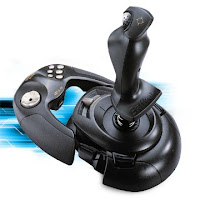Joysticks
Many games require a joystick for the proper playing of the game. There are many different types, the more sophisticated
playing of the game. There are many different types, the more sophisticated
respond to movement in 3 axis directions, as well as having a number of
configurable buttons. Like most things in life you get what you pay for with
joysticks and it is worth investing in a good, strongly constructed model,
especially bearing in mind that children will hammer these devices whilst
playing games.
Voice input for PCs (microphones) Early voice recognition systems offered very poor results, due to the
Early voice recognition systems offered very poor results, due to the
limitations of the software combined with hardware limitations. It takes an
awful lot of CPU processing power to convert the spoken word into text that
appears on the screen. Things are changing rapidly however and recent systems
allow you to talk to a PC and see text appear on the screen. Most of these
systems require an initial training period, where you train the software to
respond to your particular voice. While still not perfect this is a key
technology of the future.
Web Cams Ever since it was invented, the Web has become increasingly interactive. You can
Ever since it was invented, the Web has become increasingly interactive. You can
now use a small digital movie camera (a Web cam) mounted on the PC monitor to
allow two-way communication involving not just text communication but sound and
video communication as well. While not yet considered a standard piece of PC
kit, it is only a matter of time …
Digital Cameras A digital camera can be used in the same way a traditional camera can, but
A digital camera can be used in the same way a traditional camera can, but
instead of storing images on rolls of film which require developing, the images
are stored digitally in memory housed within the camera. These pictures can
easily be transferred to your computer and then manipulated within any graphics
programs that you have installed on your computer. Currently they are limited by
the quality of the image recorded and the number of pictures that you may storewithin the camera.

















